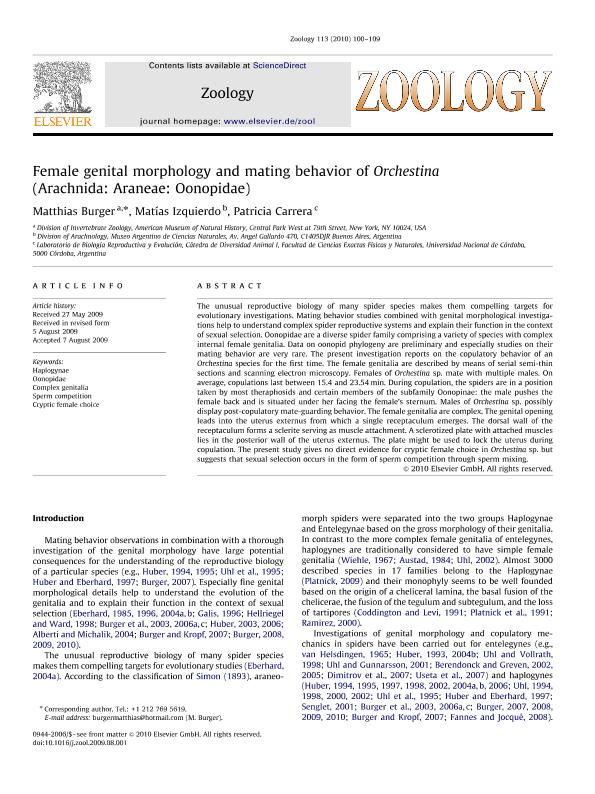Mostrar el registro sencillo del ítem
dc.contributor.author
Burger, Matthias
dc.contributor.author
Izquierdo, Matías Andres

dc.contributor.author
Carrera, Patricia Cristina

dc.date.available
2019-01-30T17:05:15Z
dc.date.issued
2010-03
dc.identifier.citation
Burger, Matthias; Izquierdo, Matías Andres; Carrera, Patricia Cristina; Female genital morphology and mating behavior of Orchestina (Arachnida: Araneae: Oonopidae); Elsevier Gmbh; Zoology; 113; 2; 3-2010; 100-109
dc.identifier.issn
0944-2006
dc.identifier.uri
http://hdl.handle.net/11336/68994
dc.description.abstract
The unusual reproductive biology of many spider species makes them compelling targets for evolutionary investigations. Mating behavior studies combined with genital morphological investigations help to understand complex spider reproductive systems and explain their function in the context of sexual selection. Oonopidae are a diverse spider family comprising a variety of species with complex internal female genitalia. Data on oonopid phylogeny are preliminary and especially studies on their mating behavior are very rare. The present investigation reports on the copulatory behavior of an Orchestina species for the first time. The female genitalia are described by means of serial semi-thin sections and scanning electron microscopy. Females of Orchestina sp. mate with multiple males. On average, copulations last between 15.4 and 23.54 min. During copulation, the spiders are in a position taken by most theraphosids and certain members of the subfamily Oonopinae: the male pushes the female back and is situated under her facing the female's sternum. Males of Orchestina sp. possibly display post-copulatory mate-guarding behavior. The female genitalia are complex. The genital opening leads into the uterus externus from which a single receptaculum emerges. The dorsal wall of the receptaculum forms a sclerite serving as muscle attachment. A sclerotized plate with attached muscles lies in the posterior wall of the uterus externus. The plate might be used to lock the uterus during copulation. The present study gives no direct evidence for cryptic female choice in Orchestina sp. but suggests that sexual selection occurs in the form of sperm competition through sperm mixing.
dc.format
application/pdf
dc.language.iso
eng
dc.publisher
Elsevier Gmbh

dc.rights
info:eu-repo/semantics/openAccess
dc.rights.uri
https://creativecommons.org/licenses/by-nc-nd/2.5/ar/
dc.subject
Complex Genitalia
dc.subject
Cryptic Female Choice
dc.subject
Haplogynae
dc.subject
Oonopidae
dc.subject
Sperm Competition
dc.subject.classification
Otras Ciencias Biológicas

dc.subject.classification
Ciencias Biológicas

dc.subject.classification
CIENCIAS NATURALES Y EXACTAS

dc.title
Female genital morphology and mating behavior of Orchestina (Arachnida: Araneae: Oonopidae)
dc.type
info:eu-repo/semantics/article
dc.type
info:ar-repo/semantics/artículo
dc.type
info:eu-repo/semantics/publishedVersion
dc.date.updated
2019-01-30T13:57:19Z
dc.journal.volume
113
dc.journal.number
2
dc.journal.pagination
100-109
dc.journal.pais
Alemania

dc.description.fil
Fil: Burger, Matthias. American Museum of Natural History; Estados Unidos
dc.description.fil
Fil: Izquierdo, Matías Andres. Consejo Nacional de Investigaciones Científicas y Técnicas. Oficina de Coordinación Administrativa Parque Centenario. Museo Argentino de Ciencias Naturales “Bernardino Rivadavia”; Argentina
dc.description.fil
Fil: Carrera, Patricia Cristina. Universidad Nacional de Córdoba. Facultad de Ciencias Exactas, Físicas y Naturales; Argentina. Consejo Nacional de Investigaciones Científicas y Técnicas; Argentina
dc.journal.title
Zoology

dc.relation.alternativeid
info:eu-repo/semantics/altIdentifier/doi/http://dx.doi.org/10.1016/j.zool.2009.08.001
dc.relation.alternativeid
info:eu-repo/semantics/altIdentifier/url/https://www.sciencedirect.com/science/article/pii/S0944200610000024
Archivos asociados
